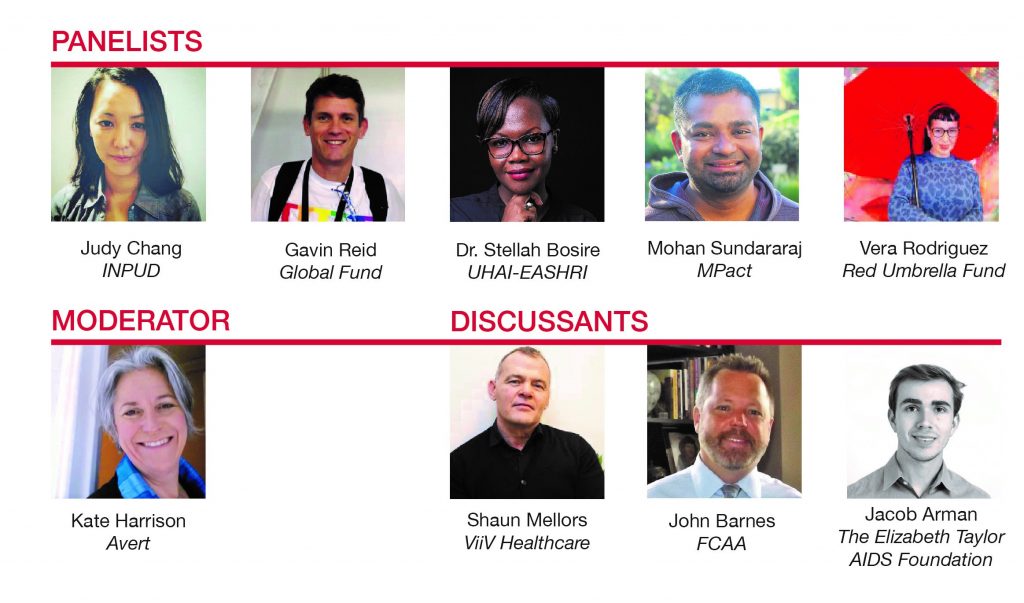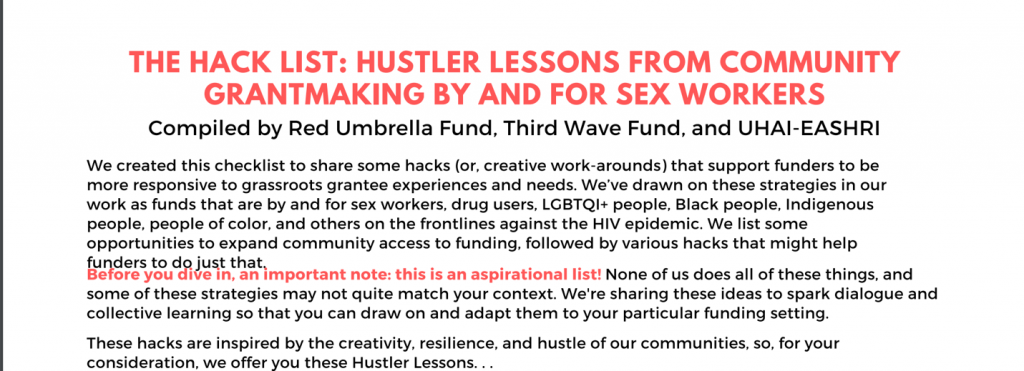Highlights from HIV2020: A Recap of the “Dollars and Sense of Effective Grantmaking” Session
This past July, FCAA and ViiV Healthcare Positive Action co-sponsored a session at HIV2020. “The Dollars and Sense of Effective Grantmaking,”was a natural progression of the work started at AIDS2018, when FCAA first shared our Last Mile in Funding: Improving Practice in Philanthropic Funding of Community Action on AIDS report. HIV2020 provided an opportunity to continue the conversation as to how funders can be more responsive to the communities we serve. While we encourage you to watch the full session, we have provided you with highlights and key take aways below.
“The days of HIV-specific funding are long over.” – Kate Harrison, Avert

Panelists addressed the fact that, when we talk about HIV funding, we are really referencing a whole host of intersectional issues such as human rights, LGBTQ rights, sex worker rights, and health access. To that end, grant makers must think more broadly and include the communities affected by these issues when making funding decisions.
To align resources with the needs of key populations, MPact’s Mohan Sundararaj suggests we start by considering the areas where funding is most needed: delivery of services, breaking down barriers, and building community. Delivery of services, he suggests, should be left to the communities. Where funders can offer support is in helping to break down structural barriers; and doing so not only when it is politically expedient, but even during the most challenging of times. It is also a crucial role of funders to build community in spaces like HIV2020 and other platforms where candid, respectful dialogue can take place.
“COVID is the torch that highlights deep-rooted discrimination, blame, prejudice, isolation, and stigma in our society.” – Shaun Mellors, ViiV Healthcare
Even in the midst of the devastation, COVID-19 has illuminated reasons for hope. It has, for example, shown us that there is money to support global health issues, though it requires concerted political will in order to find and mobilize these resources. The current crisis has also led to innovation related to technology, data, inclusive engagement, and breaking down siloes. Going forward, funders need to be creative about resourcing community-based innovations such as those produced during the COVID crisis. “It can’t be from our silos or ivory towers,” says Shaun Mellors. Rather, funders must iterate and with grantees to co-create a pipeline of innovation.
Unfortunately, COVID-19 also has exacerbated existing weaknesses. Curfews and restrictions on movement are inhibiting key populations and have made safe, affirming spaces for communities to come together inaccessible. Militarized enforcement of laws are leading to little or no accountability in regard to human rights. As people are stuck at home, there has been an increase of on- and offline surveillance of LGBTI individuals and sex workers by their neighbors. All of this contributes to a sense of isolation and fear. But the health of communities can’t be separated from the human rights of those too often marginalized in communities.
Community-led organizations are well positioned to not only identify but help mitigate some of these challenges. While UHAI doesn’t have a specific COVID fund because, Dr. Stella Bosire of UHAI-EASHRI explains, “community-responsiveness is embedded in our DNA.” To help during the crisis, the organization has focused on providing flexible and unrestricted funding to address immediate needs. It is also to do that as quickly and efficiently as it can, often within a 72-hour timeframe.
“Let’s disrupt philanthropy because philanthropy needs more community members and activist thinking!” – Vera Rodriquez, Red Umbrella Fund
Participatory grant making is key to ensuring funding meets the needs on the ground. At the Red Umbrella Fund, 11 activists review the grants each year. It is a challenging model, says Vera Rodriquez, but fair. “People on the ground will make better decisions than someone sitting in an office,” she explains.
She also recommends partnering with peer funder groups.
As one example, the Red Umbrella Fund, along with UHAI-EASHRI and Third Wave Fund, has also produced guidance for funders in the form of a “Sex Worker Hack List.” The document outlines creative ways funders can be more responsive to grassroots organizations. The document is not intended to be prescriptive, but to facilitate dialogue between funders and key population-led organizations.

“The value proposition is actually an equilibrium…The power difference that exists is a distorted imbalance.” – Dr. Stellah Bosire
There is no philanthropy without the communities they are representing. As the consumers of the investment social impact, the power, in many ways, actually lies in the community. For philanthropy to see the value of its investment, it must listen to communities.
As someone with lived experience as both a community member and a funder, Vera Rodriquez was able to paint a very clear picture. Funders have the “perceived power” through salaries, safety, and access to resources. However, communities are the gatekeepers for social change and have, as Rodriquez explains it, “the ultimate power to make change happen. And they will do it whether there is funding or not.”
For donors to relate better to community led-networks, it takes a change in thinking and a wider lens view, advises INPUD’s Judy Chang. The work of networks and movements doesn’t always fit neatly into current performance metrics. “Our work is fluid and dynamic and I think that needs to be seen as a strength,” she says.
“HIV2020 is a space to protest top to bottom approaches.” – Judy Chang, INPUD
A mantra of “communities know best what will work for them,” was oft repeated throughout the session and there was a consistent call to overcome the power dynamic inherent in a top down funding approach. To answer that call, funders and communities should work together to:
- Engage in meaningful dialogue and participatory grant making
- Establish an equal partnership in designing and budgeting grants
- Respect the context in which one another work
- Adapt to the changing needs of the community
- Think intersectionally
- Identify and work with key population-led networks
Examples of good donor practices highlighted during the session include:
- Partnering with peer funders to learn and get support
- Creating new partnerships to address emerging needs
- Flexibility in grantmaking
- An ability to tolerate risk
- Thinking beyond outreach and advocacy into, for example, research and evaluation, and comprehensive services.
A few hundred words hardly does this session justice – and I haven’t even mentioned the wonderful videos contributed by community-led organizations including UHAI-EASHRI, the Kenya Network of People who Use Drugs, Latin American Platform of Persons Who Perform Sex Work, and Gays and Lesbians of Zimbabwe. Again, I encourage everyone to watch the full session. This is a continuing dialogue that FCAA is committed to facilitating and we look forward to hearing your feedback!